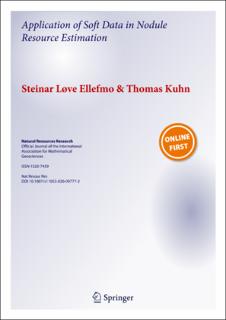| dc.contributor.author | Ellefmo, Steinar Løve | |
| dc.contributor.author | Kuhn, Thomas | |
| dc.date.accessioned | 2021-01-26T08:26:22Z | |
| dc.date.available | 2021-01-26T08:26:22Z | |
| dc.date.created | 2020-11-11T16:18:08Z | |
| dc.date.issued | 2020 | |
| dc.identifier.citation | Natural Resources Research. 2020, 1-23. | en_US |
| dc.identifier.issn | 1520-7439 | |
| dc.identifier.uri | https://hdl.handle.net/11250/2724666 | |
| dc.description.abstract | Minerals and metals are of uttermost importance in our society, and mineral resources on and beneath the deep ocean floor represent a huge potential. Deciding whether mining from the deep ocean floor is financially, environmentally and technologically feasible requires information. Due to great depths and harsh conditions, this information is expensive and time and resource consuming to obtain. It is therefore important to use every piece of data in an optimum way. In this study, data retrieved from images and expert knowledge were used to estimate minimum and maximum nodule abundances at image locations from an area in the Clarion-Clipperton-Zone of the equatorial North East Pacific. From the minimum and maximum values, box cores and the spatial correlation quantified through variogram, a conditional expectation and associated uncertainty were obtained through the Gibbs sampler. The conditional expectation and the uncertainty were used with the assumed certain abundance data from the box cores in a kriging exercise to obtain better informed estimates of the block by block abundance. The quality assessment of the estimations was done based on distance criterion and on kriging quality indicators like the slope of regression and the weight of the mean. From the original image locations, alternative image configurations were tested, and it was shown that such alternatives produce better estimates, without extra costs. Future improvements will focus on improving the estimation of the minimum and the maximum values at image locations. | en_US |
| dc.language.iso | eng | en_US |
| dc.publisher | Springer | en_US |
| dc.relation.uri | http://link.springer.com/article/10.1007/s11053-020-09777-2 | |
| dc.rights | Navngivelse 4.0 Internasjonal | * |
| dc.rights.uri | http://creativecommons.org/licenses/by/4.0/deed.no | * |
| dc.subject | Mineralutvinning på havbunnen | en_US |
| dc.subject | Deep sea mining | en_US |
| dc.subject | Marine mineraler | en_US |
| dc.subject | Marine minerals | en_US |
| dc.subject | Geostatistikk | en_US |
| dc.subject | Geostatistics | en_US |
| dc.title | Application of Soft Data in Nodule Resource Estimation | en_US |
| dc.type | Peer reviewed | en_US |
| dc.type | Journal article | en_US |
| dc.description.version | publishedVersion | en_US |
| dc.source.pagenumber | 1-23 | en_US |
| dc.source.journal | Natural Resources Research | en_US |
| dc.identifier.doi | 10.1007/s11053-020-09777-2 | |
| dc.identifier.cristin | 1847087 | |
| dc.description.localcode | Open Access This article is licensed under a Creative Commons Attribution 4.0 International License, which permits use, sharing, adaptation, distribution and reproduction in any medium or format, as long as you give appropriate credit to the original author(s) and the source, provide a link to the Creative Commons licence, and indicate if changes were made. The images or other third party material in this article are included in the article's Creative Commons licence, unless indicated otherwise in a credit line to the material. If material is not included in the article's Creative Commons licence and your intended use is not permitted by statutory regulation or exceeds the permitted use, you will need to obtain permission directly from the copyright holder. To view a copy of this licence, visit http://creativecommons.org/licenses/by/4.0/. | en_US |
| cristin.ispublished | true | |
| cristin.fulltext | original | |
| cristin.qualitycode | 1 | |

